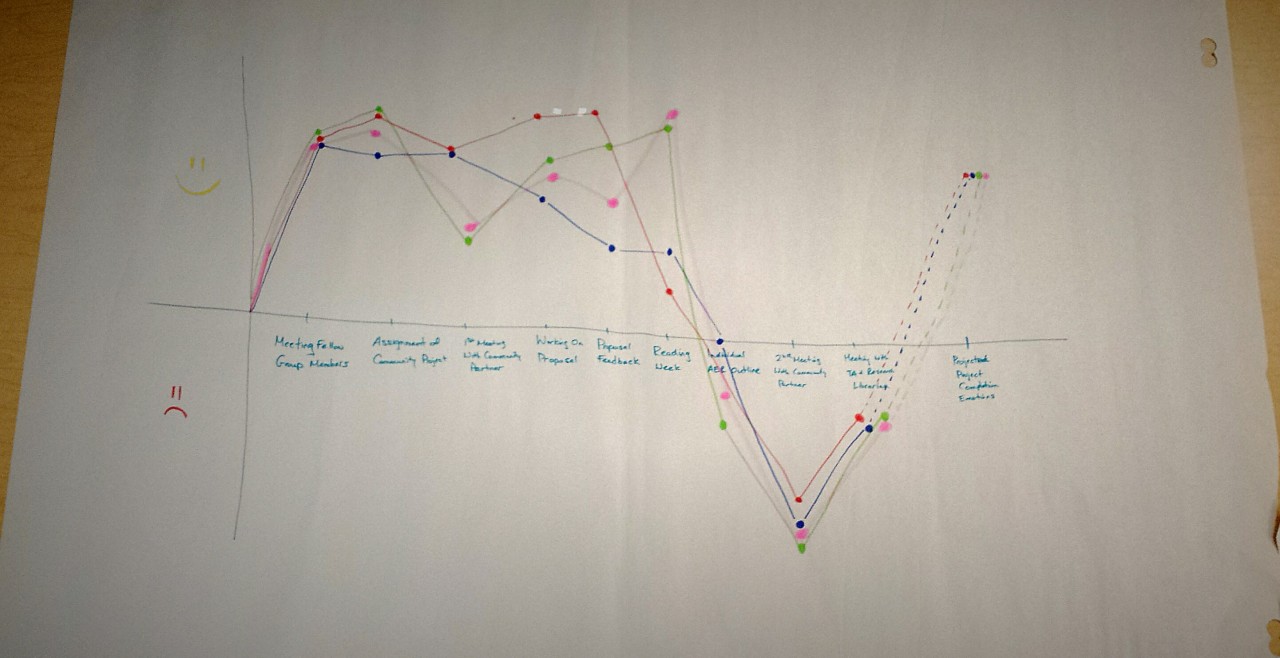By Lloyd Smith, CC BY-SA 3.0, https://commons.wikimedia.org/w/index.php?curid=26218152
It’s been about a month since our last blog post and we’re here to bring you an update on the progress of our community project! The upward trek has been a struggle as we have experienced a scenario very similar to many other community projects.We are tempted to compare it to climbing to the summit on Mt. Everest! As we encountered a very unexpected shift, this left our group with a wide range of mixed emotions. Keep reading to learn about Group 14’s obstacles and our steps to overcoming them!

Moment of Significant Change
Our significant moment of change was definitely our second meeting with our community partner on March 1st. Referencing the details posted on the LFS 350 projects website, we were hoping to discuss our role in updating the HIM recipe book and promotional material of HIM’s Rainbow Soup Social. During our meeting, we realized that our group project expectations did not align with the community partner’s vision in terms of our participation with HIM. This resulted in some disappointment on our side, as some of the aspects of the project which we had really liked in the beginning, were no longer going to be available to us to participant in. As a result, we have had to completely shift the scope of our project and change our overall project goals.
Such a significant change in scope and goals brings with it anxiety and uncertainty which are things that people typically seek to avoid. However, in “Pedagogies of Uncertainty,” Lee Shulman notes that it is not enough for education to be grounded in theory alone, and that it is in practice, particularly in circumstances of uncertainty that the greatest learning occurs (Shulman, 2005). For us, the change in scope meant a shift from categorizing and building upon existing physical assets, such as promotional materials, recipes, and a community resource guide, to focusing on how community organizations such as HIM can use food as a means to build social capital. Social relationships and social capital are at the core of Asset Based Community Development, where social capital is a latent asset, and the associations and social networks developed can be used to mobilize other assets within a community (Mathie & Cunningham, 2003). Despite the anxiety that comes with an unexpected change in direction, it is our hope that by the end of our project we will be able to provide HIM with a series of recommendations that they can use to improve food related community initiatives.
Achievements
In order to meet the changes in needs from our community partner, we have had frequent team meetings to discuss our approach on completing a literature review for HIM, based on our research question: “How can community organizations use food as a means to build social capital and foster community development?”
Within the past two weeks, we have accomplished the following:
- Arranged a meeting with Carrie, our LFS 350 TA to discuss the change in scope of our community project and strategies to proceed with our literature review
- Scheduled and attended a meeting with Katherine, the Reference Librarian for Food, Nutrition, and Health to help us with our database search strategies in addressing our research question
- Discussed the secondary objectives of our community project with Will, our LFS 350 instructor (interviews with our community partner and HIM’s coordinator, promotional materials, and updating HIM’s recipe book)
- Completed a revised draft of our literature review for our community partner, to be submitted electronically to our community partner, by the end of March 11th.
Weekly Objectives
As we approach the last couple weeks of the term, we will be working diligently towards wrapping up the contents of our community project. We look forward to presenting our polished copy of our literature review at our third community partner meeting on March 15th. Upon meeting with our community partner, we hope to gain traction on the project and move forward past the challenges. We hope he provides us with the necessary inside-insight on how we can tackle our secondary objectives with the remaining time we have left in the term. With the change in scope of our project and new information from our community partner, we will have a better understanding and idea on how to reformulate our proposal in order to reflect the various changes that have occurred within the past two weeks. Our next steps after adjusting our proposal will be to work towards incorporating some parts of the literature review into our final community project report.
Strategies for a Graceful Dismount
In spite of the challenges we have faced so far, our group remains hopeful that we will be able to participate in a Rainbow Soup Social and assist HIM through informed recommendations gathered from the literature review and associated research articles.
Will Group 14 eventually attend HIM’s Rainbow Soup Social? If you are as intrigued about the outcome as much as we are, please stay tuned for our fourth and final blog posting to find out!
References
Mathie, A., & Cunningham, G. (2003). From clients to citizens: Asset-based Community Development as a strategy for community-driven development. Development in Practice, 13(5), 474–486.
Shulman, L. S. (2005). Pedagogies of uncertainty. Liberal Education, 91(2), 18–25. Retrieved from http://files.eric.ed.gov/fulltext/EJ697350.pdf
